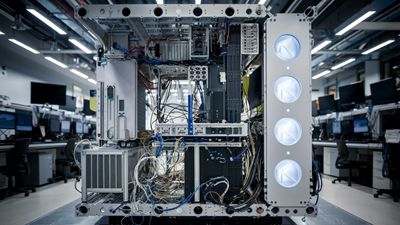Challenging Nvidia’s Blackwell: How AI Chipmakers Are Battling for a Share of the Booming Market
Nvidia’s Market Dominance and Blackwell’s Impact
Nvidia’s Blackwell processors have positioned the company at the forefront of the AI chip market. The introduction of Blackwell has not only reinforced Nvidia’s market dominance but also set a high benchmark for competitors. Nvidia’s data center revenue reached a record $26.3 billion in the last quarter of 2023, marking a 154% year-over-year increase. This growth is largely attributed to the strong demand for Blackwell, which is expected to generate several billion dollars in revenue starting in Q4 2024.
The Blackwell GPUs are anticipated to produce around $10 billion in revenue in Q4 2024 alone, significantly surpassing analysts’ expectations. Nvidia’s strategic partnerships, such as the expanded collaboration with Accenture, further enhance its market position by facilitating rapid AI adoption across industries. These factors underscore Nvidia’s robust competitive edge and highlight the challenges faced by other AI chipmakers in closing the gap.
Cerebras Systems: A Rising Competitor
Cerebras Systems has emerged as a notable competitor to Nvidia, particularly with its innovative Wafer-Scale Engine (WSE-3). Launched in 2024, the WSE-3 features 900,000 AI-optimized cores and 4 trillion transistors, making it the largest commercially available AI processor. This product is designed to compete directly with Nvidia’s H100 chip, offering 57 times the size and 52 times more compute cores, along with 88 times more on-chip memory and 7,000 times more memory bandwidth.
Despite its technological advancements, Cerebras faces significant challenges in capturing market share from Nvidia. The company reported remarkable revenue growth, achieving $136.4 million in the first half of 2024, a 1467% increase from the same period in 2023. However, Cerebras remains heavily reliant on a single customer, Group 42 Holding, which contributed 87% of its revenue in H1 2024. This dependency poses a risk to its long-term growth prospects.
Cerebras’ strategic initiatives, including its IPO under the ticker symbol “CBRS” and the launch of the Cerebras Cloud, aim to diversify its customer base and capture a share of the rapidly growing AI computing market, projected to reach $453 billion by 2027. These efforts position Cerebras as a formidable competitor, but the company must overcome its reliance on a single customer and expand its market presence to effectively challenge Nvidia.
AMD and Intel: Struggling to Keep Pace
AMD and Intel, two of Nvidia’s primary competitors, have struggled to keep pace with Nvidia’s rapid growth in the AI chip market. As of the end of 2023, AMD reported data center revenue of $2.8 billion, up 115% year-over-year, while Intel’s data center and AI revenue was $3 billion, a decline of 3% from the previous year. These figures highlight the significant disparity in market presence between Nvidia and its competitors.
AMD’s data center GPU revenue is anticipated to reach at least $4.5 billion in 2024, illustrating the vast gap between the two companies. Despite this, AMD continues to invest in AI technologies and has made strides in developing competitive products. However, the company’s market share remains limited compared to Nvidia’s dominant position.
Intel, on the other hand, has faced challenges in maintaining its market share amid declining revenue. The company’s strategic focus on AI and data center technologies has yet to yield significant results, as evidenced by its declining revenue figures. Intel’s ability to compete with Nvidia will depend on its capacity to innovate and deliver high-performance AI chips that meet the growing demands of the market.
The Broader AI Chip Market and Emerging Trends
The AI chip market is poised for significant growth, with Nvidia currently controlling between 70% and 95% of the market. The overall market for agentic AI is valued at $30.89 billion in 2024, with a projected compound annual growth rate (CAGR) of 31.68%. This growth is driven by increasing enterprise investments in AI technologies and the adoption of more autonomous AI systems.
Nvidia’s partnership with Accenture aims to enhance agentic AI capabilities in businesses, catalyzing innovation and productivity within enterprises. This collaboration underscores the strategic importance of AI in driving operational transformation and efficiency enhancements across industries.
As the AI chip market continues to evolve, other competitors may emerge to challenge Nvidia’s dominance. The strategic focus on agentic AI and the growing demand for high-performance AI chips present opportunities for new entrants to capture market share. However, the competitive landscape remains challenging, with established players like Nvidia maintaining a significant advantage.
Conclusion
Nvidia’s Blackwell processors have solidified the company’s position as the dominant player in the AI chip market. The “insane” demand for Blackwell underscores Nvidia’s competitive edge and highlights the challenges faced by other AI chipmakers in catching up. Cerebras Systems, AMD, and Intel are making strides to compete with Nvidia, but significant disparities in market presence and technological capabilities remain.
Cerebras’ innovative WSE-3 processor and strategic initiatives position it as a formidable competitor, but the company must overcome its reliance on a single customer to effectively challenge Nvidia. AMD and Intel continue to invest in AI technologies, but their market shares remain limited compared to Nvidia’s dominant position.
The AI chip market is poised for significant growth, driven by increasing enterprise investments and the adoption of autonomous AI systems. While Nvidia currently dominates the market, emerging trends and technological advancements present opportunities for other competitors to capture market share. However, the competitive landscape remains challenging, with Nvidia maintaining a significant advantage in the AI chip market for 2024 and beyond.


